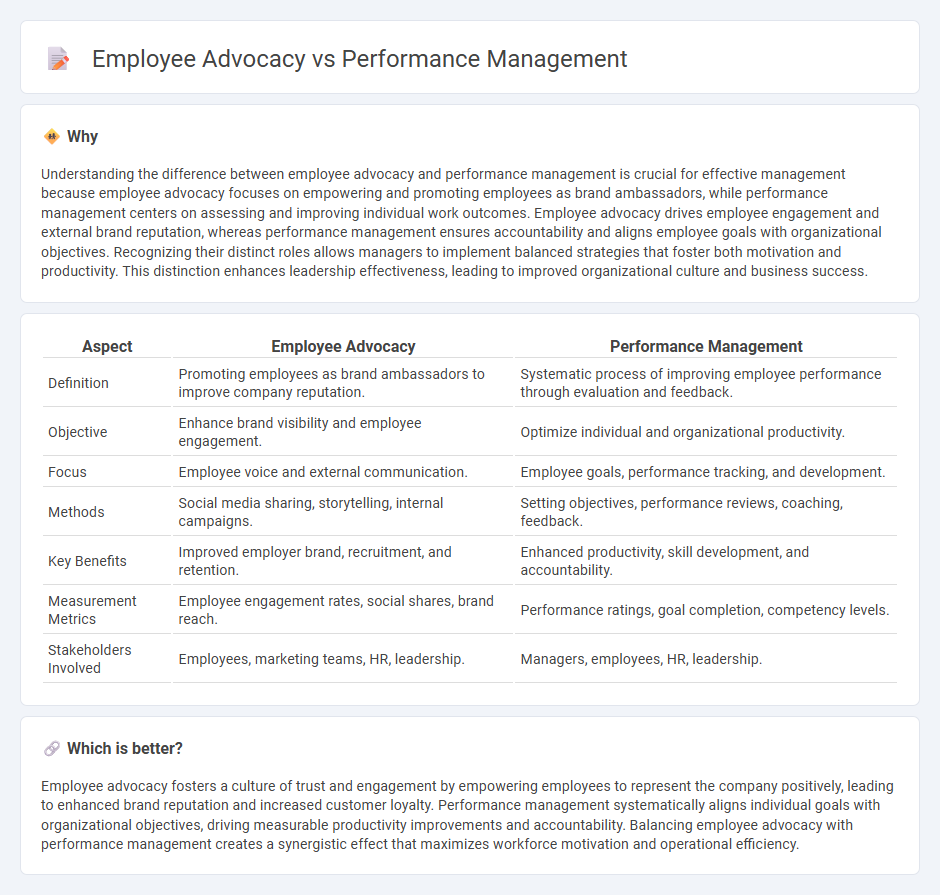
Employee advocacy focuses on empowering staff to promote the company brand authentically, enhancing reputation and engagement through genuine employee voices. Performance management involves systematic processes to evaluate, develop, and optimize employee productivity aligned with organizational goals. Explore how integrating these approaches drives holistic workforce excellence and business success.
Why it is important
Understanding the difference between employee advocacy and performance management is crucial for effective management because employee advocacy focuses on empowering and promoting employees as brand ambassadors, while performance management centers on assessing and improving individual work outcomes. Employee advocacy drives employee engagement and external brand reputation, whereas performance management ensures accountability and aligns employee goals with organizational objectives. Recognizing their distinct roles allows managers to implement balanced strategies that foster both motivation and productivity. This distinction enhances leadership effectiveness, leading to improved organizational culture and business success.
Comparison Table
| Aspect | Employee Advocacy | Performance Management |
|---|---|---|
| Definition | Promoting employees as brand ambassadors to improve company reputation. | Systematic process of improving employee performance through evaluation and feedback. |
| Objective | Enhance brand visibility and employee engagement. | Optimize individual and organizational productivity. |
| Focus | Employee voice and external communication. | Employee goals, performance tracking, and development. |
| Methods | Social media sharing, storytelling, internal campaigns. | Setting objectives, performance reviews, coaching, feedback. |
| Key Benefits | Improved employer brand, recruitment, and retention. | Enhanced productivity, skill development, and accountability. |
| Measurement Metrics | Employee engagement rates, social shares, brand reach. | Performance ratings, goal completion, competency levels. |
| Stakeholders Involved | Employees, marketing teams, HR, leadership. | Managers, employees, HR, leadership. |
Which is better?
Employee advocacy fosters a culture of trust and engagement by empowering employees to represent the company positively, leading to enhanced brand reputation and increased customer loyalty. Performance management systematically aligns individual goals with organizational objectives, driving measurable productivity improvements and accountability. Balancing employee advocacy with performance management creates a synergistic effect that maximizes workforce motivation and operational efficiency.
Connection
Employee advocacy enhances organizational culture by promoting transparency and trust, which directly impacts performance management outcomes. Engaged employees who actively advocate for their company demonstrate higher motivation and accountability, leading to improved goal attainment and productivity metrics. Integrating employee advocacy strategies into performance management systems fosters continuous feedback loops and reinforces aligned behaviors that drive business success.
Key Terms
**Performance Management:**
Performance management in organizations involves systematically evaluating and improving employee performance through goal setting, continuous feedback, and performance appraisals to align individual contributions with business objectives. It fosters productivity by identifying skill gaps and development opportunities that enhance workforce capabilities and drive organizational success. Explore how effective performance management strategies can transform employee engagement and operational outcomes.
Key Performance Indicators (KPIs)
Key Performance Indicators (KPIs) in performance management are quantifiable metrics used to evaluate employee productivity, goal achievement, and overall contribution to organizational success. Employee advocacy measures the extent to which employees promote the company's brand and values, often assessed through employee engagement scores and social media activity metrics. Explore further to understand how integrating KPIs enhances both performance management and employee advocacy strategies.
Feedback
Performance management centers on structured feedback to evaluate and improve employee productivity, aligning individual goals with organizational objectives through regular appraisals and performance reviews. Employee advocacy involves authentic feedback channels that empower employees to share their experiences and insights, fostering a culture of trust and transparency. Explore how leveraging both feedback strategies can drive engagement and overall business success.
Source and External Links
What Is Performance Management? The Complete Guide - AIHR - Performance management is an ongoing process involving regular communication between managers and employees to assess job responsibilities, set SMART goals, provide continuous feedback, and foster employee growth aligned with organizational performance.
What is Employee Performance Management? - Qualtrics - Performance management balances employee value delivery with business goals through clear expectations, ongoing feedback, and technology-enabled tracking and coaching to enhance communication, development, and goal alignment.
Performance Management - KU's Human Resources - Performance management is a continuous process of clarifying job responsibilities, setting goals, providing feedback regularly throughout the evaluation period, and aligning individual performance with organizational objectives for development and improvement.
 dowidth.com
dowidth.com